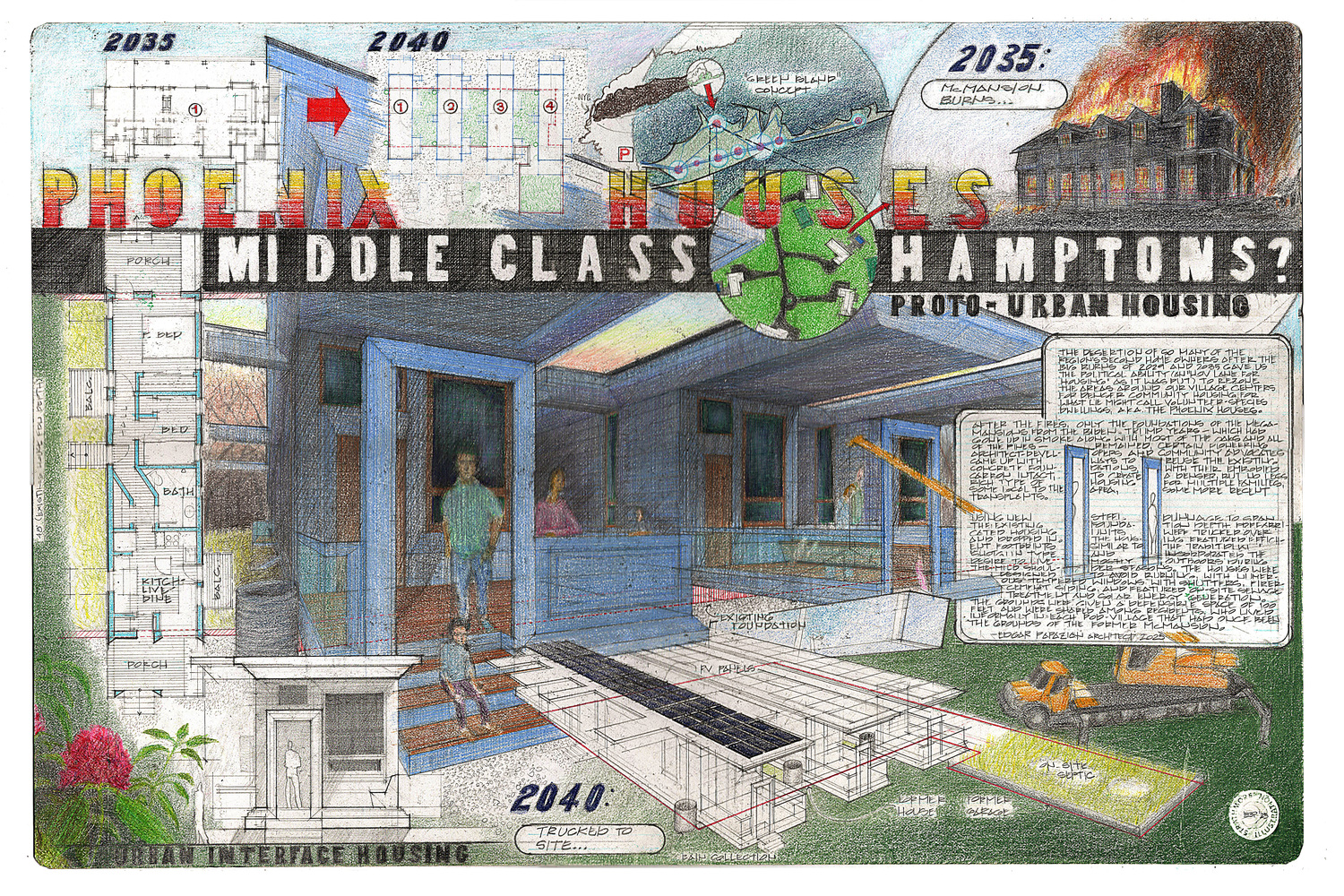
A Noyac architect took a different tack with his entry into this year’s AIA Peconic Design Awards, an architecture competition held annually by the East End’s chapter of the American Institute of Architects. Edgar Papazian submitted a protest entry based on a hypothetical future where the Hamptons has been twice devastated by wildfires and is now rebuilding as a middle class enclave.
In a hand-drawn illustration and an accompanying narrative, the entry envisions that many Hamptons second-home owners deserted the region after the wildfires in 2029 and 2035 destroyed the South Fork’s Biden and Trump era mega-mansions. The wealthy’s abandonment created the political ability to rezone areas around village centers for denser community housing.
In 2040, prebuilt, narrow, “shotgun style” homes are trucked in to achieve that goal. Papazian titled the entry “Phoenix Houses,” as the new homes are installed on the foundations of burned out mansions.
“Middle Class Hamptons?” and “Proto-Urban Housing” are written across the illustration, which was completed with colored pencils.
“I have concerns. I think a lot of people are concerned,” Papazian said. “And so I guess I was just trying to reflect that, instead of submitting some glitzy project for billionaires.
He explained that the notion behind his protest entry was to fight back against the monoculture in the Hamptons in which most architects work on very high-end residential projects, and to start a conversation about the future and what kind of housing might be needed locally to support a vibrant community.
“A lot of the issues that we have locally, including things like the trade parade, etc., are actually housing problems,” he said.
Papazian said part of the mission of AIA Peconic is to promote DEI — diversity, equity and inclusion — and he noted that the group has hosted a series of public conversations on regional planning that have been provocative in terms of looking at codes and zoning.
There has been a big conversation nationally, he added, regarding having more housing and “not regulating everything to the point where we can’t actually build the housing that people need to live.”
Papazian has been an architect for 24 years, 12 of them in the Hamptons. He’s also a professor at the New York Institute of Technology School of Architecture and Design.
“I have to admit, having lived out here for a while now, that what people are building and the kind of scale of development that’s happening, is changing the character of the place,” he said, adding that the natural beauty that people live here for is slowly slipping away with every clear-cut property and developer McMansion.
“Being an architect, I’m kind of adjacent to all that. I call it the real estate-industrial complex,” he said.
He said there is a lot of room to build very good, smart housing in the Hamptons, and “we shouldn’t be afraid of that. Rather than thinking of the Hamptons as a haven for the 1 percent, he suggested thinking of the region as a vibrant around the year community.
Papazian hopes people take it in the spirit that it was intended and that his goal was not to offend anyone.
“There’s actually a long history of this idea of a protest entry in architectural competitions,” he said.
Entries in the awards, regardless of whether they win or lose anything, are still reviewed by contest jurors and are exhibited during the awards ceremony.
“I’m not really an outsider to AIA Peconic,” Papazian pointed out. “I was the president last year.”